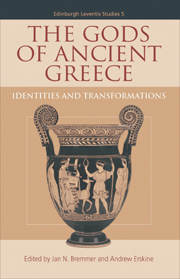Book contents
- Frontmatter
- Contents
- Preface
- List of Illustrations
- Notes on Contributors
- List of Abbreviations
- Introduction: The Greek Gods in the Twentieth Century
- 1 What is a Greek God?
- PART I SYSTEMATIC ASPECTS
- PART II INDIVIDUAL DIVINITIES AND HEROES
- PART III DIACHRONIC ASPECTS
- 14 Early Greek Theology: God as Nature and Natural Gods
- 15 Gods in Early Greek Historiography
- 16 Gods in Apulia
- 17 Lucian's Gods: Lucian's Understanding of the Divine
- 18 The Gods in the Greek Novel
- 19 Reading Pausanias: Cults of the Gods and Representation of the Divine
- 20 Kronos and the Titans as Powerful Ancestors: A Case Study of the Greek Gods in Later Magical Spells
- 21 Homo fictor deorum est: Envisioning the Divine in Late Antique Divinatory Spells
- 22 The Gods in Later Orphism
- 23 Christian Apologists and Greek Gods
- 24 The Materiality of God's Image: Olympian Zeus and Ancient Christology
- PART IV HISTORIOGRAPHY
- Epilogue
- Index
24 - The Materiality of God's Image: Olympian Zeus and Ancient Christology
from PART III - DIACHRONIC ASPECTS
Published online by Cambridge University Press: 05 August 2013
- Frontmatter
- Contents
- Preface
- List of Illustrations
- Notes on Contributors
- List of Abbreviations
- Introduction: The Greek Gods in the Twentieth Century
- 1 What is a Greek God?
- PART I SYSTEMATIC ASPECTS
- PART II INDIVIDUAL DIVINITIES AND HEROES
- PART III DIACHRONIC ASPECTS
- 14 Early Greek Theology: God as Nature and Natural Gods
- 15 Gods in Early Greek Historiography
- 16 Gods in Apulia
- 17 Lucian's Gods: Lucian's Understanding of the Divine
- 18 The Gods in the Greek Novel
- 19 Reading Pausanias: Cults of the Gods and Representation of the Divine
- 20 Kronos and the Titans as Powerful Ancestors: A Case Study of the Greek Gods in Later Magical Spells
- 21 Homo fictor deorum est: Envisioning the Divine in Late Antique Divinatory Spells
- 22 The Gods in Later Orphism
- 23 Christian Apologists and Greek Gods
- 24 The Materiality of God's Image: Olympian Zeus and Ancient Christology
- PART IV HISTORIOGRAPHY
- Epilogue
- Index
Summary
THE LIVING GOD AND HIS OR HER IMAGE
In the ancient world people imagined a god or a goddess by referring to a double ‘image’ of the divine being: one is the invisible and immaterial god in opposition to the visible and material world of humankind; the other represents it as a material image, in shape and size almost that of a human being. As I will argue in this chapter, most people were aware of the difference between these two images. Christians, however, accused their pagan adversaries of confusing the two – by taking the material representation as the invisible living god, they worshipped a dead stone, a tree or a beast. Yet the Christians themselves blurred the border between the divine and humankind, since they identified the invisible god with the material and visible man Jesus. They developed this notion by looking back to an older discourse on adequate images of divine beings:
a discourse on Pheidias' masterpiece of the Olympian Zeus as the ideal representation of the invisible god;
a parallel discourse which argues that the relation between the invisible god and the material man called his son can be understood in the same framework as the relations between god and his image. In this respect the man Jesus Christ is the material visible image of God.
- Type
- Chapter
- Information
- The Gods of Ancient GreeceIdentities and Transformations, pp. 465 - 480Publisher: Edinburgh University PressPrint publication year: 2010

